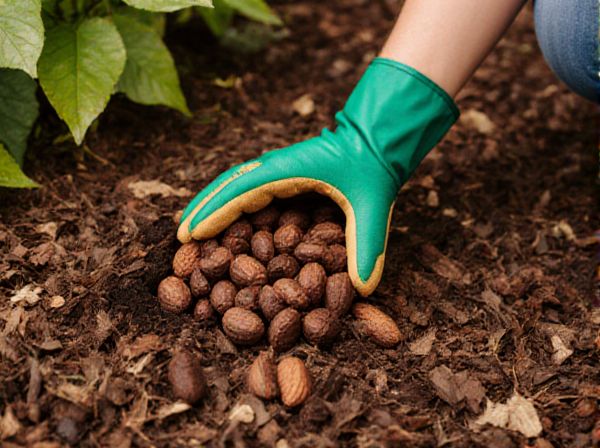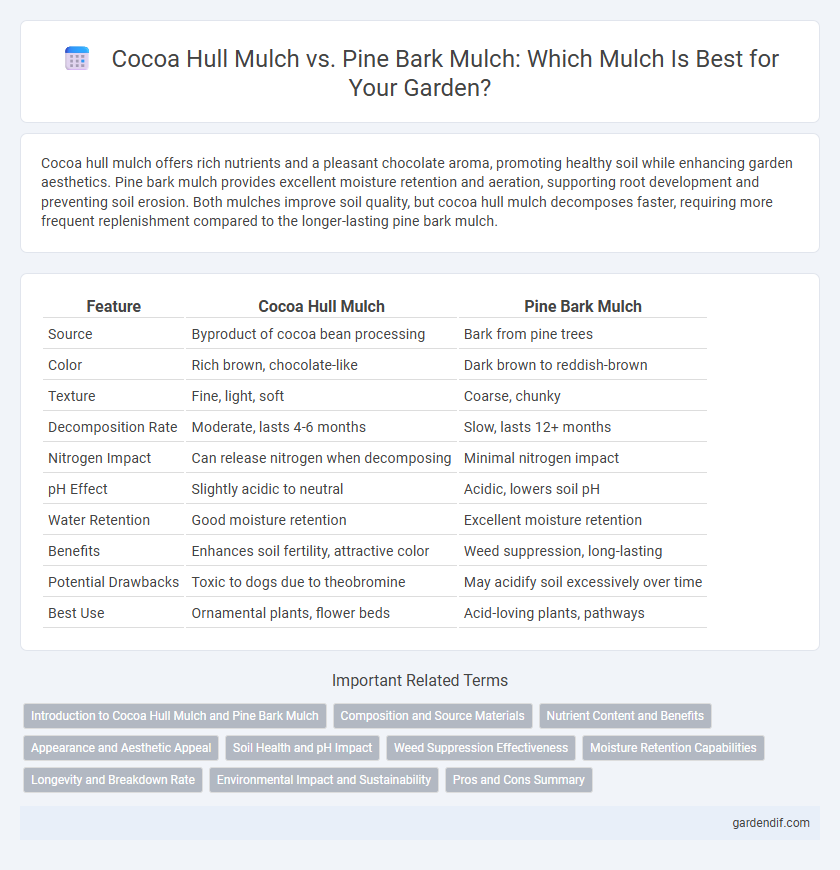
Cocoa hull mulch vs Pine bark mulch Illustration
Cocoa hull mulch offers rich nutrients and a pleasant chocolate aroma, promoting healthy soil while enhancing garden aesthetics. Pine bark mulch provides excellent moisture retention and aeration, supporting root development and preventing soil erosion. Both mulches improve soil quality, but cocoa hull mulch decomposes faster, requiring more frequent replenishment compared to the longer-lasting pine bark mulch.
Table of Comparison
| Feature | Cocoa Hull Mulch | Pine Bark Mulch |
|---|---|---|
| Source | Byproduct of cocoa bean processing | Bark from pine trees |
| Color | Rich brown, chocolate-like | Dark brown to reddish-brown |
| Texture | Fine, light, soft | Coarse, chunky |
| Decomposition Rate | Moderate, lasts 4-6 months | Slow, lasts 12+ months |
| Nitrogen Impact | Can release nitrogen when decomposing | Minimal nitrogen impact |
| pH Effect | Slightly acidic to neutral | Acidic, lowers soil pH |
| Water Retention | Good moisture retention | Excellent moisture retention |
| Benefits | Enhances soil fertility, attractive color | Weed suppression, long-lasting |
| Potential Drawbacks | Toxic to dogs due to theobromine | May acidify soil excessively over time |
| Best Use | Ornamental plants, flower beds | Acid-loving plants, pathways |
Introduction to Cocoa Hull Mulch and Pine Bark Mulch
Cocoa hull mulch, derived from the shells of cocoa beans, offers a rich brown color and a pleasant chocolate aroma that enhances garden aesthetics while improving soil moisture retention and nutrient content. Pine bark mulch, made from the bark of pine trees, provides excellent weed control and soil insulation, with a slow decomposition rate that benefits long-term soil health. Both mulches contribute organic matter but differ in texture, nutrient composition, and suitability for specific plants and soil conditions.
Composition and Source Materials
Cocoa hull mulch is derived from the outer shells of cocoa beans, providing a nutrient-rich organic material high in nitrogen and natural theobromine compounds, which can promote soil health. Pine bark mulch, sourced from the bark of pine trees, offers a durable, slow-decomposing organic matter that improves soil aeration and water retention while slightly acidifying the soil due to its lignin and resin content. Both mulches serve different gardening needs based on their distinct compositions: cocoa hull mulch enhances fertility with its nutrient profile, whereas pine bark mulch excels in structural soil improvement and pH adjustment.
Nutrient Content and Benefits
Cocoa hull mulch is rich in nitrogen, potassium, and magnesium, promoting healthy plant growth and enhancing soil fertility, while its natural aroma can deter pests. Pine bark mulch provides excellent aeration and moisture retention, containing slower-decomposing organic matter that gradually releases nutrients, particularly phosphorus and potassium. Both mulches improve soil structure but cocoa hull mulch offers quicker nutrient availability, whereas pine bark mulch supports long-term soil health.
Appearance and Aesthetic Appeal
Cocoa hull mulch boasts a rich, dark brown color and a fine texture that enhances garden beds with a polished, elegant look, while pine bark mulch offers a rugged, coarse appearance featuring deep reddish-brown hues that complement natural landscapes. Cocoa hull mulch maintains a smooth surface that slowly weathers to a soft gray, adding seasonal visual interest, whereas pine bark mulch retains its chunky form, providing strong contrast against green foliage. Both mulches improve garden aesthetics, but cocoa hull mulch is often favored for upscale ornamental gardens due to its uniformity and subtle scent.
Soil Health and pH Impact
Cocoa hull mulch enriches soil with organic matter and nutrients, promoting beneficial microbial activity while slightly raising soil pH to a more neutral level, ideal for many plants. In contrast, pine bark mulch tends to acidify the soil, making it suitable for acid-loving plants but potentially limiting nutrient availability for others. Both mulches improve soil structure and moisture retention, but their pH impact should guide selection based on specific soil health requirements.
Weed Suppression Effectiveness
Cocoa hull mulch provides moderate weed suppression due to its dense texture and natural compounds that inhibit weed growth, making it suitable for garden beds. Pine bark mulch offers superior weed suppression because of its coarse texture and ability to form a thick barrier that limits sunlight penetration. Both mulches improve soil moisture retention and temperature regulation, but pine bark mulch excels in preventing weed seed germination and establishment.
Moisture Retention Capabilities
Cocoa hull mulch offers superior moisture retention due to its fine texture and natural oils, which help reduce evaporation and keep soil consistently moist. Pine bark mulch, while effective in insulating soil, tends to allow quicker drying because of its coarser structure and larger particle sizes. Gardens requiring longer-lasting moisture typically benefit more from cocoa hull mulch's enhanced water retention properties.
Longevity and Breakdown Rate
Cocoa hull mulch typically decomposes faster than pine bark mulch, offering nutrient-rich organic matter that benefits soil health within a shorter timeframe. Pine bark mulch is known for its extended longevity, often lasting up to two years due to its dense, fibrous structure that resists breakdown. The slower decomposition rate of pine bark mulch provides longer-lasting weed control and moisture retention compared to the quicker breakdown of cocoa hull mulch.
Environmental Impact and Sustainability
Cocoa hull mulch is biodegradable and adds organic matter to soil but can pose risks to pets due to the presence of theobromine, while pine bark mulch is more widely available and decomposes slower, reducing the frequency of replacement. Pine bark mulch supports sustainable forestry practices when sourced responsibly, contributing to carbon sequestration and soil erosion prevention. Both mulches improve moisture retention and soil health, but pine bark mulch generally offers a lower environmental footprint through its longevity and renewable harvesting methods.
Pros and Cons Summary
Cocoa hull mulch enhances soil fertility with its rich organic content and pleasant aroma, but poses toxicity risks to pets and may mold in wet conditions. Pine bark mulch offers excellent moisture retention, long-lasting durability, and pest resistance, yet it decomposes more slowly and can be more acidic, potentially affecting soil pH. Both mulches improve soil health, but selection depends on specific garden needs, pet safety, and maintenance preferences.
Cocoa hull mulch vs Pine bark mulch Infographic

 gardendif.com
gardendif.com